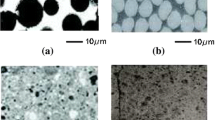Abstract
The paper deals with numerical identification of the average elastic properties of particle-reinforced composite materials. The finite element method for the determination of deformation energy of the characteristic volume element was used. In earlier analytical investigations, an approximation function of the averaged elastic properties of the composite was derived. An identification procedure allows the estimation of the unknown approximation parameters from numerical experiments. The obtained functions describe precisely the numerical data for any relationships between constituents of the material.
Similar content being viewed by others
References
H. Sol, J. de Visscher, and W. P. de Wilde, “Identification of the viscoelastic material properties of orthotropic plates using a mixed numerical/experimental technique,” in: C. A. Brebbia and G. M. Carlomagno (eds.), Computational Methods and Experimental Measurements VI. Vol. 2. Stress Analysis, Elsevier Appl. Sci., London-New York (1993), pp. 131–142.
H. Sol, “Identification of anisotropic plate rigidities using free vibration data,” PhD Thesis, Free University of Brussels (VUB) (1986).
L. Bolognini, F. Riccio, and F. Bettianli, “A model technique for the identification of stiffness and mass parameters in large structures,” C. A. Brebbia and G. M. Carlomagno (eds.), Computational Methods and Experimental Measurements VI. Vol. 2. Stress Analysis, Elsevier Appl. Sci., London-New York (1993), pp. 337–352.
C. M. Mota Soares, M. Moreira de Freitas, and A. L. Aiaujo, “Identification of material properties of composite plate specimens,” Compos. Struct.,25, 277–285 (1993).
V. Kushnevsky, “Effective elastic properties of particulate-reinforced composite materials,” Mech. Compos. Mater.,33, No. 4, 315–321 (1997).
R. M. Christensen and K. H. Lo, “Solutions for effective shear properties in three phase sphere and cylinder models,” J. Mech. Phys. Solids,27, 315–330 (1979).
Z. Hashin, “The elastic moduli of heterogeneous materials. A survey,” J. Appl. Mech.,29, 143–150 (1962).
B. W. Rosen and Z. Hashin, “Effective thermal expansion coefficients and specific heat of composite materials,” Int. J. Eng. Sci.,8, 157–173 (1970).
Additional information
Institute of Computer Analysis of Structures, Riga Technical University, Riga PDP-1658, Latvia. Institute of Materials Science, Department of Materials Science, Martin-Luther-University Halle-Wittenberg, D-06099 Halle, Germany. Published in Mekhanika Kompozitnykh Materialov, Vol. 34, No. 3, pp. 383–390, May–June, 1998.
Rights and permissions
About this article
Cite this article
Kushnevsky, V. Numerical identification of properties of particle-reinforced composite materials. Mech Compos Mater 34, 279–284 (1998). https://doi.org/10.1007/BF02256047
Received:
Issue Date:
DOI: https://doi.org/10.1007/BF02256047




